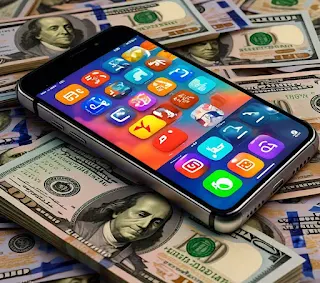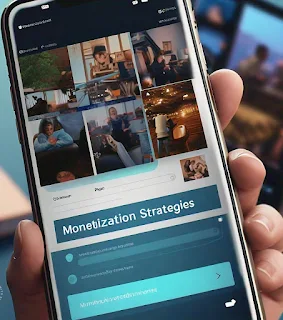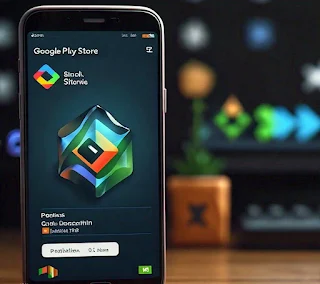Introduction
With the rise of digital interactions, social apps like
Instagram, TikTok, Facebook, and YouTube have seen exponential growth. Creating
your own social media app presents a lucrative opportunity, especially when
paired with the right monetization strategies. Whether you're a beginner or a
seasoned developer, this guide provides in-depth steps on building a social
app, publishing it on the Google Play Store, and earning money via Google
AdMob, alternative ad networks, and premium features.
Part 1:
Creating a Social App from Scratch
1. Identify Your App's Niche and Concept
1)
Define Your Target Audience: Determine
if your app will cater to a global audience, specific age groups, or
interest-based communities (gaming, lifestyle, or education).
2)
Develop a Unique Concept: Social
media is highly competitive, so think about how your app will stand out. Will
it be based on short-form content like TikTok or focus on privacy and data
security? Defining your unique selling point (USP) is critical.
2.
Choose the Right App Development Tools
1)
Native Development: For optimal
performance, consider using Kotlin or Java for Android app development.
2)
Cross-Platform Tools: Consider Flutter
or React Native for quick deployment on both Android and iOS. These
tools allow developers to code once and deploy across multiple platforms,
saving time and resources.
3)
Backend Solutions: Use Node.js,
Firebase, or Django for secure backend development, providing
features like authentication, data storage, and real-time synchronization.
3.
Essential Features to Include in a Social App
1)
User Profiles: Allow users to create detailed profiles with photos,
bios, and personal details.
2)
Content Sharing: Build features for users to upload and share photos,
videos, and status updates.
3)
Messaging and Notifications: Provide
in-app messaging with push notifications to increase user engagement.
4)
Live Streaming: Consider adding real-time live streaming to drive more
interactions, similar to Instagram and TikTok live features.
5)
Hashtags and Search: Integrate
hashtag systems, making it easier for users to discover trending content.
6)
Video/Story Posting: Allow
short-form videos or disappearing posts to increase interactivity.
Example App Idea: Name your app "TrendMate"—a
hybrid social platform that combines elements of TikTok and Instagram, focused
on micro-video content with enhanced privacy settings.
4.
App Testing and Feedback
1)
Beta Testing: Release a beta version to gather feedback from users
about bugs and functionality.
2)
Quality Assurance: Conduct
extensive testing across devices and network conditions to ensure the app works
smoothly, regardless of user environments.
Part 2: Monetization Strategies for Your Social App
1. Google AdMob Integration
·
Banner Ads: Use unobtrusive banner ads at the bottom of the app.
·
Rewarded Video Ads: Let users
watch ads to unlock special features or in-app currency.
·
Interstitial Ads: Display these
between transitions, like switching between stories or videos.
2.
Explore Alternative Ad Networks
·
Unity Ads and AppLovin: These are great alternatives to
AdMob, especially if you want to diversify your revenue streams.
·
Facebook Audience Network:
Leverage Facebook's powerful advertising network for high-value ads.
·
Chartboost: Specializes in mobile games but can be adapted for
social apps if the content is appropriate.
3.
In-App Purchases and Subscriptions
·
Offer Premium Memberships:
Introduce a subscription model where users pay monthly to access ad-free
experiences or exclusive features.
·
Selling Virtual Goods: Similar
to Instagram badges or TikTok coins, allow users to buy virtual gifts,
stickers, or enhanced profile customization.
4.
Affiliate Marketing
·
Partner with companies to promote their products
through content creators on your platform. Offer users a commission-based model
where they can recommend products, and the app earns a percentage of the sale.
Part 3: Publishing on Google Play Store
1. Create Your Developer Account
·
Before publishing your app, register for a Google Play
Developer account and pay the $25 one-time registration fee.
2.
Submit Your App to Google Play Store
·
Prepare APK: Generate the APK (Android Package) file of your app,
making sure it passes all security and optimization checks.
·
App Store Optimization (ASO):
Optimize your app's title, description, keywords, and categories to improve
discoverability on the Google Play Store.
3.
Additional App Stores
·
Consider also publishing on Amazon Appstore, Aptoide,
or Samsung Galaxy Store to reach more users and diversify your audience.
Part 4: Creating Apps Similar to Instagram, Facebook,
and TikTok
1. Features for a Full-Fledged Social Media App
1)
Create core functionalities similar to Facebook’s
timeline, Instagram’s feed, and TikTok’s video-sharing model.
2)
Video Editing Tools: Let users edit
videos with filters, music, and effects, similar to TikTok.
3)
Content Discovery: A dynamic
"Explore" page that uses algorithms to suggest relevant posts to
users based on their behavior and preferences.
Trending Name Suggestion: "VibeNet"—a
video-focused app where users can share short clips, audio tracks, and status
updates while interacting in real-time with their followers.
Part 5: Integrating Monetization via Google AdMob and
AdSense
1. Google AdMob Setup
·
Integrate AdMob by linking it to your Google Developer
account and configuring ad placements (banner ads, interstitials, and video
ads).
2.
AdSense for Websites
·
If you have a web version of your app, integrate Google
AdSense into your website to generate additional revenue from web traffic.
Part 6: Deposit and Withdrawal of In-App Earnings
1.
Deposit Methods
·
Integrate popular payment gateways like Stripe, PayPal,
or Google Pay for users to deposit funds and make purchases within the
app.
2.
Withdraw Earnings
·
Offer users simple withdrawal options for any earnings,
such as payouts via PayPal, bank transfers, or cryptocurrency
wallets, ensuring a smooth and transparent process.
Part 7: Game Development Platforms to Consider for App
Creators
1.
QuickApp Ninja: This platform helps you create Android games quickly
without coding skills. You can add Google AdMob ads to generate revenue from
your games.
2.
WePlay Game Engine: Another
no-code platform for creating engaging mobile games with monetization options,
ideal for beginners looking to dive into the mobile app market.
3.
Unity and Unreal Engine: For more advanced game
developers, these engines offer powerful tools for creating high-quality games
and apps that can be monetized through ad networks and in-app purchases.
Short Summary
Building and monetizing an app requires a clear vision,
technical expertise, and a sound business model. Whether it's a social media
app or a gaming platform, the opportunities for app developers are vast. By
incorporating monetization strategies like AdMob, in-app purchases, and
affiliate marketing, your app can become a profitable venture. Follow the steps
outlined above, and you could have the next trending social app on Google Play
Store, reaching millions and generating revenue.
Here's a
step-by-step guide to creating a comprehensive social media app that combines
the best features of Instagram, Threads, Reddit, Tumblr, Quora, Pinterest,
TikTok, YouTube, and Telegram. This guide will not only take you through the
development process but also cover how to publish your app and monetize it
effectively.
Ultimate Guide to Creating a Social
App with Monetization Strategies
Introduction
Social media
apps have become a dominant force in today's digital world, and the potential
to create a successful app that combines the best features of popular platforms
is enormous. This guide will walk you through the entire process of creating a
powerful social media app that incorporates the strengths of platforms like
Instagram, Threads, Reddit, Tumblr, Pinterest, and others. You’ll also learn
how to monetize the app using advertising networks, in-app purchases, and other
revenue-generating methods.
Step
1: Planning Your Social Media App
1.1 Identifying Your App’s Purpose:
1) Define the
App's Focus: Decide whether
your app will focus on photo sharing (like Instagram), short videos (like
TikTok), or community discussions (like Reddit or Quora). The app can be a
blend of these elements, offering users multiple ways to connect and engage.
2) Target
Audience: Understanding
who your users will be is crucial. For example, if you're blending Pinterest
and Instagram, your target audience might be creative individuals, influencers,
or businesses.
1.2 Unique
Features of Your App:
Here’s a
breakdown of features that can be combined from multiple platforms:
1) Image &
Video Sharing: Like Instagram
and TikTok, users can share images, videos, and short stories.
2) Text Posts
& Threads: Similar to
Reddit and Threads, allow users to engage in discussions or create posts in
threads.
3) Boards &
Collections: Users can
create collections or boards like Pinterest.
4) Group Messaging
& Channels: Borrow
Telegram’s channel and group chat system for users to engage in large or
private conversations.
5) Live Streaming: Incorporate
YouTube-like live streaming for real-time user interaction.
1.3 Design
Elements and Branding:
1) Create a Name
for Your App: Think of a
creative, catchy, and easy-to-remember name. Something like
"SocialSphere" or "ConnectHub" could work well.
2) Logo and
Branding: Design a
professional logo and theme for your app. Make sure it resonates with your
target audience.
Step
2: Development Process
2.1 Choosing Your Development Tools:
You have
several options for building your app:
1) Native
Development: Use Kotlin
or Java for Android, and Swift for iOS to ensure the best
performance.
2) Cross-Platform
Frameworks: If you want to
launch the app on Android, iOS, and web, frameworks like Flutter, React
Native, or Xamarin are great for code reusability.
Alternatively,
you can use app development platforms that allow non-coders to create apps
quickly:
1) QuickApp Ninja: A no-code
platform to create apps with AdMob monetization integration.
2) WePlay Game
Engine: If you want a
gaming element in your app, WePlay offers an easy setup.
3) Appy Pie: A
beginner-friendly drag-and-drop app builder that supports both iOS and Android.
2.2 Key App
Features:
Here’s a list
of features that your app will include:
1.
User Registration/Login: Using email,
phone number, or social media accounts like Facebook, Instagram, or Google.
2.
User Profiles: Each user should have a customizable
profile, with bio, photo, and links.
3.
Feed & Timeline: Like Instagram or TikTok, allow users
to see recent posts or stories from people they follow.
4.
Hashtags and Categories: Users can tag
posts, allowing content to be easily searchable, similar to Twitter or
Instagram.
5.
Messaging & Group Chats: Borrow from
Telegram or Reddit’s chat feature to allow direct messaging and group
conversations.
6.
Video Sharing & Streaming: Users can
share short videos or even go live for streaming, similar to YouTube and
TikTok.
7.
Content Moderation: Set up moderation tools like Reddit
to ensure the content complies with your platform’s rules.
8.
Push Notifications: Keep users updated with likes,
comments, and new messages.
2.3 Backend
Development:
1.
Server & Database: Use Node.js
with MongoDB for real-time scalability or Firebase for a quick
setup and cloud hosting.
2.
API Development: Build APIs to manage user data,
posts, and interactions.
3.
Cloud Storage: Use services like AWS S3 or Firebase
Storage for hosting user-uploaded media.
2.4 App Testing
and Debugging:
Test your app
on various devices and platforms to ensure it works smoothly. Use tools like TestFlight
(iOS) or Firebase App Distribution (Android) for beta testing. Gather
feedback from beta testers and fix bugs accordingly.
Step
3: Publishing Your App
3.1 Setting Up Developer Accounts:
1.
Google Play Store: You’ll need to create a Google
Developer Account to publish your app. There’s a one-time fee of $25.
2.
Apple App Store: For iOS, create an Apple Developer
Account for $99/year.
3.2 Preparing
Your App for Publishing:
1.
App Metadata: Write a compelling description for
your app, include eye-catching screenshots, and upload your logo. Keywords are
essential for App Store Optimization (ASO), so be sure to include
popular terms like "social app," "photo sharing,"
"live streaming," etc.
2.
Privacy Policy & Terms of Service: Make sure your
app complies with Google’s AdSense policies, privacy laws like GDPR, and
terms of service. You can use tools like Termly to generate these
policies.
3.3 Publishing
on the App Store:
Once your app
is ready, submit it for review on the Google Play Store and Apple App Store.
Make sure your app follows the guidelines and passes the review process.
Step
4: Monetizing Your App
4.1 In-App Advertising:
1.
Google AdMob: This is one of the best ways to
monetize your app. AdMob allows you to display ads in various formats like
banners, interstitials, and rewarded video ads. You can earn money every time a
user clicks on or views an ad.
2.
Alternative Ad Networks: In addition to
AdMob, you can explore Facebook Audience Network, Unity Ads, or AppLovin
for better ad diversity.
4.2 In-App
Purchases & Subscriptions:
- Offer users premium features, such as removing
ads, unlocking special filters or content, or accessing premium groups or
chats.
- You can also set up a subscription model where
users pay monthly for exclusive features, similar to Reddit's Premium or
YouTube's Premium.
4.3 Affiliate
Marketing:
- Sponsored Content: Partner with brands and influencers who can
promote their products or services within your app. You can charge for
sponsored posts or affiliate marketing links where you earn a commission
for every sale generated.
4.4 Freemium
Model:
- This model allows users to download and use your
app for free with basic features, but charge them for additional features
or to remove ads. Freemium apps often see high user engagement
because of their free access.
Step
5: How to Earn Money from the App
1. Ad Revenue: You can integrate AdMob, Facebook Audience Network, or Unity Ads to display ads and generate revenue.
2.
In-App Purchases: Offer in-app purchases for exclusive
features, filters, or premium accounts, which can provide a steady source of
income.
3.
Subscription Plans: Charge users monthly fees for ad-free
experiences, special content, or VIP access, like Instagram’s subscription
model.
4.
Affiliate Marketing: Promote products from brands and earn
commissions on sales through affiliate marketing partnerships.
5.
Sponsored Posts: Work with businesses or influencers
to create sponsored content in your app.
Best Ad Networks for Monetization:
- Google AdMob: Best for beginners with a large audience.
- Facebook Audience Network: High engagement rates.
- AppLovin:
Good for gaming and entertainment apps.
- Unity Ads: Perfect for apps with a video or gaming focus.
Monetize your
own social app successfully
Creating a
successful social app is a complex but rewarding journey. By blending the
features of popular platforms and focusing on user engagement, you can build an
app that stands out in the crowded social media space. Moreover, effective
monetization through ads, in-app purchases, and subscriptions can ensure
long-term profitability. Following Google AdSense and privacy policies ensures
your app remains compliant while generating income.
This
step-by-step guide ensures you have everything you need to develop, launch, and
monetize your own social app successfully.







































.jpeg)




0 Comments